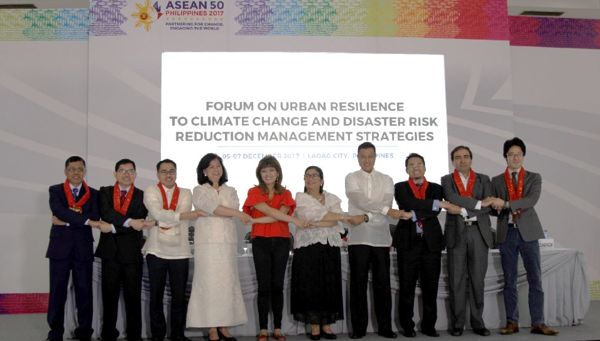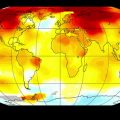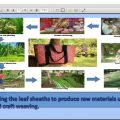ASEAN countries have committed to adopt “Green Growth” policies in urban areas that are the largest emitters of greenhouse gases in order to arrest adverse effects, mainly destructive floodings, arising from these pollutants that cause global warming.
In a press conference during the “Urban Resilience and Disaster Risk Management” forum, Ecosystems Research & Development Bureau (ERDB) Director Dr. Henry A. Adornado said a resolution from the forum will enhance information and technology transfer and exchange between countries on disaster risk management.

These disaster risk management plans are urgently needed.
“With the high vulnerability of Southeast Asian cities to the effects of climate change resulting in higher frequencies of tropical storms, unprecedented flooding, drought, heat waves, and sea level rise, this forum serves as an important reminder that urban resiliency is an urgent agenda that we have to work with” said Department of Environment and Natural
Resources Undersecretary Atty. Jonas R. Leones.
He represented DENR Sec. Roy A. Cimatu of the DENR during the forum.
More than 150 participants came to the forum from Association of Southeast Asian Nations (ASEAN) including Indonesia, Lao PDR, Malaysia, Myanmar, Thailand, Vietnam, Brunei Darussalam.
There were also representatives from development partner countries China, India, and Japan. It was held in Laoag City, Ilocos Norte, a province known to be often visited by dry weather or drought.
“The pursuit of urban resilience and green growth in major cities sets a new norm to sustainable development and survival of more than half of the world’s population living in the metropolis. This is a timely response as it is projected that by 2050, 66% of the global population will be residing in urban areas,” said Dr. Simplicia A. Pasicolan, forum coordinator.
An exhibit also featured four important themes: Tools and Methodologies for Climate Change Impacts Assessments, Urban Resilience and Green Growth Strategies, Institutional Structures, Policies and Programs, and Management Strategies for Disaster Risk Reduction. This ceremony was led by Ilocos Norte Gov. Imee Marcos and Elizabeth P. Buensuceso, Philippines’ ambassador to ASEAN.
Adornado said a continuous collaboration and information exchange on studies in disaster risk management will ensure concrete plans and actions will be implemented by ASEAN.
During the last ten years, ASEAN countries have experienced more intense effects of rising temperature due to the effects of global warming.
It is attributed to the release of greenhouse gases (GHG) carbon dioxide, methane, nitrous oxide, ozone, chlorofluorocarbons, water vapor, and hydroclorofluorocarbons.
They are thrown into the environment by human activities from combustion of fossil fuels—oil, coal, natural gas—for running vehicles, power plants and electricity supply for industries and homes.
Its severe negative impact is on ecosystems, biodiversity, and people’s livelihood.
It is estimated that the current rate of man’s global GHG emission may be contributing to a temperature rise exceeding 2 degrees centigrade which is the upper limit set in order to avoid risk-full global warming by 2036.
“The end in view is to come up with a list of experiences, information and strategies among ASEANs in their struggle to attain urban resilience to climate change and highlighting the various coping mechanisms and adaptive capacities of each participating member,” said Adornado.
Urban areas are considered drivers of global warming that leads to climate change. World Bank (2011) reported that 80% of GHG emissions are originating from city residents.
Evidence on resource scarcity, and land degradation resulting to biodiversity loss shows that urbanization is responsible for many of the unsustainable trends pushing the planet beyond its ecological boundaries (Rockstrom et al 2009).
Their contribution in the changing environment is attributable to the economies of high production and consumption with the concentration of industries and transportation.
This scenario is likely to continue given that urban population is expected to increase by at least 2.5 billion by 2050 (UN, 2014).
Cities largely use about 75% of the earth’s natural resources and contribute to an estimated 67% of global energy consumption, and 71 % of global energy-related C02 emissions, which add to the upsurge of climate change (World urbanization Prospects,2014 Revision; OECD, 2013).
(Growth Publishing for ERDB).
FREQUENTLY ASKED QUESTIONS
Q: What are the objectives of the Forum?
A: The general objective is to provide a forum for the exchange of information on strategies and experiences in addressing climate change and urban resilience among ASEAN member states including their dialogue and development partners. Specifically, this forum aims to: 1. Exchange information generated through R&D (research and development) on coping mechanisms and adaptation strategies on the impacts of climate change in the region 2. Share updates on attaining urban resilience and green growth perspectives 3. Enhance the involvement and participation of policy and decision makers, resource managers and researcher in highly urbanized areas in developing climate adaptation strategies 4. Identify issues and challenges in addressing urban vulnerability and impacts of climate change 5. Identify R&D gaps in developing strategies for urban resilience in the light of climate change 6. Discuss future plans towards attaining sustainable urbanization and green growth.
Q: What are the major themes that will be discussed in this event?
A: 1. Tools and Methodologies for Climate Change Impacts Assessments – Risks, Hazards, and Vulnerability Assessment – Greenhouse Gas Inventory and Life Cycle Analysis – Urban Environment and Natural Resources Accounting and Valuation – Institutional Capacity Assessment – GIS Remote Sensing for Climate Change Impact Assessment 2. Urban Resilience and Green Growth Strategies – Green Growth Strategies – Mass Transport – Renewable Energy – Green Building or Sustainable Infrastructure – Human Settlement and Green Spaces – Water Governance and Management – Urban Resiliency Assessment and Gender Roles – Waste Management Programs ERDB News Dispatch: Forum on Urban Resilience to Climate Change and Disaster Risk Reduction Management Strategies – Land Use Change 3. Institutional Structures, Policies and Programs – National Policies and Local Urban Initiatives – Land Use Planning and Zoning of Urban Areas – Green Building Code – Energy Fuel Policy
4. Management Strategies for Disaster Risk Reduction – Disaster Prevention and Preparedness – Disaster Response, Rehabilitation, and Recovery – Adaptation Strategies and Coping Mechanisms – Development of Financing Facilities for Adaptation – Sustainable Financing for Urban Resilience to Climate Change
Q: Who is the lead agency for this event?
A: The Ecosystems Research and Development Bureau (ERDB) of the Department of Environment and Natural Resources (DENR) is the focal agency organizing this forum. ERDB as the research arm of the DENR is mandated to produce research and development activities focusing on ecosystems such as the urban areas in the Philippines.
Q: Who are the participants of this forum?
A: Participants consist of 100 delegates from various academic, research institutions of the ASEAN member countries, namely: Indonesia, Laos, Malaysia, Myanmar, Thailand, Vietnam, Brunei Darussalam, and Philippines, as well as our developmental and dialogue partners from Japan, South Korea, India, and Bangladesh. There are also representatives from dialogues and development partners (China, Japan).
Q: What is urban resilience?
A: Urban Resilience – the capability of urban areas not only to live with changes, disturbances, adversities or disasters but also to adapt, innovate and transform into new more desirable configurations. City resilience describes the capacity of cities to function so that people living and working in cities – especially the poor and vulnerable – survive and thrive no matter what shocks and stresses they encounter (Rockerfeller Foundation & ARUP, 2014, p. 3)
Resilient cities are cities that have the ability to absorb, recover and prepare for future shocks (economic, environmental, social & institutional). Resilient cities promote sustainable development, well-being and inclusive growth (OECD).
Q: Why should we give emphasis on urban resilience?
A: Urban areas are complex with highly interdependent systems. With these interdependencies, systems failures can result in cascading impacts that can disrupt the availability of services including but not limited to, clean water, electricity, and communications.
For any questions or interview requests, please contact 0929-715-8669, 0917-102-6734 (Growth Publishing for ERDB)






